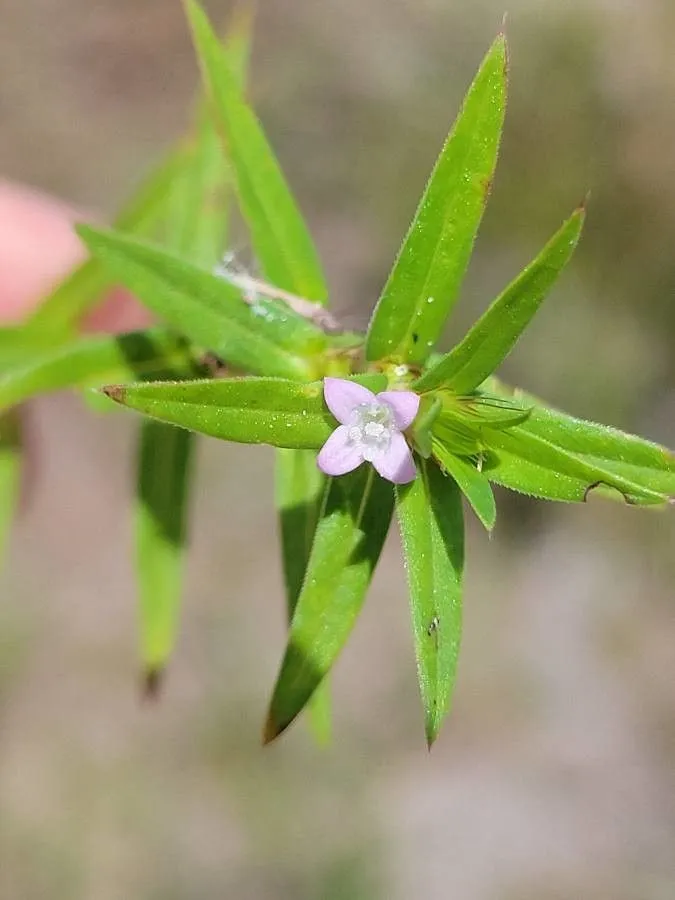
Author: J.H.Kirkbr. (Walter)
Bibliography: J. Bot. Res. Inst. Texas 8: 17 (2014)
Year: 2014
Status: accepted
Rank: species
Genus: Hexasepalum
Vegetable: False
Observations: U.S.A. to Trop. America
Poorjoe, botanically known as Hexasepalum teres, is an intriguing member of the Rubiaceae family. This resilient plant finds its range extending from the United States into tropical regions of the Americas, indicating its adaptability to a variety of climates and terrains.
First documented in detail by J.H. Kirkbride and published in the Journal of the Botanical Research Institute of Texas in 2014, Poorjoe has drawn the attention of botanists and plant enthusiasts alike due to its unique characteristics and widespread presence.
Hexasepalum teres typically grows in open, sunny areas where it can take advantage of the full spectrum of sunlight. Despite the often harsh environments it inhabits, this hardy plant demonstrates a remarkable ability to thrive with minimal care. Its resilience makes it a curious subject for studying ecological adaptations and survival strategies among flora.
The plant itself is relatively modest in appearance, yet it plays a pivotal role in its ecosystems. Poorjoe often serves as ground cover, helping to prevent soil erosion and providing habitats for various microfauna. Moreover, its presence in both temperate and tropical regions hints at its significant ecological amplitude.
Understanding the role of Poorjoe in its native habitats could yield insights into broader ecological dynamics and the health of those environments. Conservationists and ecologists are thus encouraged to pay close attention to Hexasepalum teres as an indicator species, capable of signaling changes within its ecosystems.
In summary, Poorjoe, or Hexasepalum teres, is a remarkable plant whose resilience and adaptability are a testament to the intricate balance of nature. Its wide geographical range from the U.S.A to tropical America, documented comprehensively by J.H. Kirkbride in 2014, underscores its ecological significance and enduring presence in the plant kingdom.
En: Poorjoe, ROUGH BUTTONWEED, Buttonweed
Pt: Corre-mundo
Taken Nov 19, 2019 by Sylvain Piry (cc-by-sa)
Taken Jan 15, 2020 by Luiza pazete Luiza pazete (cc-by-sa)
Taken Jan 17, 2021 by Lauton Everton (cc-by-sa)
Taken Sep 19, 2022 by Lauren Sullivan (cc-by-sa)
Taken Jan 15, 2020 by Luiza pazete Luiza pazete (cc-by-sa)
Taken Apr 12, 2021 by Amorim Ana Paula (cc-by-sa)
Taken Aug 26, 2022 by kelly mace (cc-by-sa)
Taken Jan 1, 1900 by EOL − Smithsonian Institution, National Museum of Natural History, Department of Botany (cc-by-nc-sa)
Taken Aug 15, 2012 by EOL − Sharpj99 (cc-by-nc-sa)
Taken Jan 1, 1900 by EOL − Gerrit Davidse (cc-by-nc-sa)
Taken Jan 1, 1900 by EOL − Gerrit Davidse (cc-by-nc-sa)
Taken Aug 30, 2021 by Matthew Horrigan (cc-by-sa)
Taken Oct 21, 2022 by xusta (cc-by-sa)
© copyright of the Board of Trustees of the Royal Botanic Gardens, Kew.
© copyright of the Board of Trustees of the Royal Botanic Gardens, Kew.
© copyright of the Board of Trustees of the Royal Botanic Gardens, Kew.
Growth habit: Forb/herb
Family: Myrtaceae Author: (F.Muell.) K.D.Hill & L.A.S.Johnson Bibliography: Telopea 6: 402 (1995) Year: 1995 Status:…
Family: Rubiaceae Author: Pierre ex A.Froehner Bibliography: Notizbl. Bot. Gart. Berlin-Dahlem 1: 237 (1897) Year:…
Family: Sapindaceae Author: Koidz. Bibliography: J. Coll. Sci. Imp. Univ. Tokyo 32(1): 38 (1911) Year:…
Family: Asteraceae Author: A.Gray Bibliography: Pacif. Railr. Rep.: 107 (1857) Year: 1857 Status: accepted Rank:…
Family: Fabaceae Author: Medik. Bibliography: Vorles. Churpfälz. Phys.-Ökon. Ges. 2: 398 (1787) Year: 1787 Status:…
Family: Aspleniaceae Author: (Cav.) Alston Bibliography: Bull. Misc. Inform. Kew 1932: 309 (1932) Year: 1932…